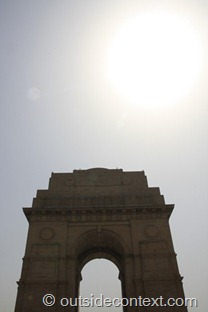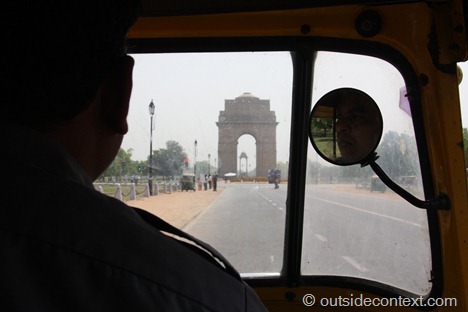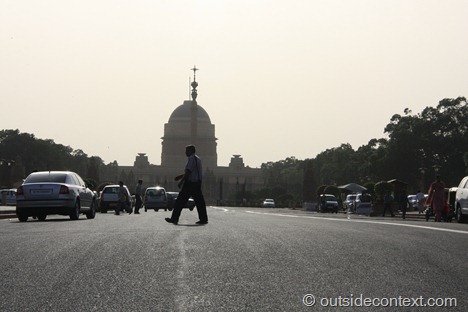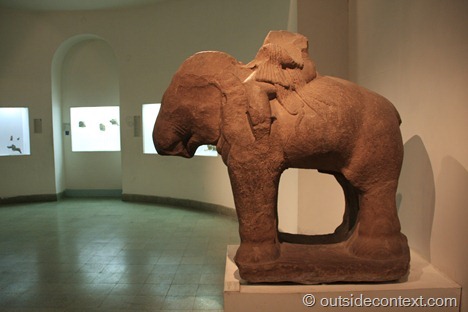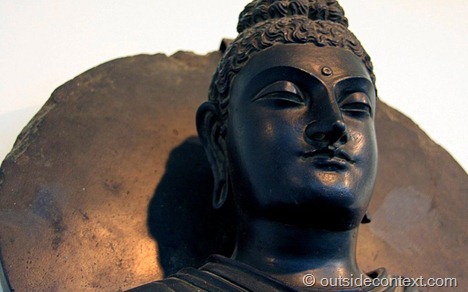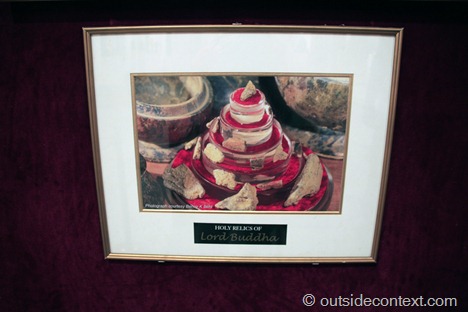Delhi. Many people say they have “done” Delhi, but in all honesty they haven’t. They have perhaps done the tourist parts of New Delhi, or maybe spent some time in an Ashram there – which amounts to the same thing: a tourist experience. Delhi is so large to be beyond being “done” should you spend a lifetime there.
For one thing there are 16 million people living in Delhi and 249 thousand in New Delhi (the capital of the capital). This makes Delhi the 8th largest metropolis in the world (we will visit the largest towards the end of these journals), and once something gets that big you know that no two stories of visiting it will be the same. Each will be a “slice of life”, a “moment in time” and a “vision” of the city. Also, like other gigantic cities, it is more than possible to leave with a very un-favourable impression. Walk down the wrong street or pass by the wrong district in any major city and you may not come out the other side alive, but perhaps in Delhi of all these places are you risking coming out a different colour.
That is because coming here during the Hindu festival of Holi, white and vulnerable, must make you a serious paint target as if you are running the gauntlet of 16 million amateur Jackson Pollacks’. That’s what first went through my mind when we arrived on the train, our last train journey in India.
As our tuk tuk wheeled through the city centre traffic towards our hotel I considered Delhi. It has been a city for over 3 thousand years and classical Hindu belief is that it is even older than that (being the capital mentioned in the Mahabharata). Given that huge mountain of history each conqueror had controlled the city for only a relatively brief moment, but they have all left their scars on it. None more so than my own nation, the British, who built buildings and monuments of Victorian scale everywhere you look. The Victorians had a wonderful sense of history and how to make their mark on it before becoming it in the past tense. The British wanted everyone to know that while Gandhi was right when he said, “All empires rise and fall”, that the sun setting on the British Empire was going to be remembered.
Indeed in this the British were right. The passing of the British Empire will forever be held up as exactly how not to do such a thing. Muslims and Hindus, suddenly deprived of their common Christian foe, turned on each other in weeks of violence that led to the murder of Gandhi himself. This was followed by over 2 million dying during marches to found the new nations of Pakistan and India, and an arms race that could go nuclear in the bad way any day now.
The tuk tuk turned into a tourist province, the street narrowed to a more modern district and we were amongst our own people: travellers.
There maybe only two types of traveller who comes to Delhi. Those who entered the country somewhere else, such as Mumbai, and are used to Indian cities. They have a knowing slouching insolence on their faces and in their dress. They have the relaxed look of people who don’t know how dirty they are. The other type is those poor unfortunates for which Delhi is their first port of call in their “Indian adventure”. They have a wide-eyed look, much newer clothing and are all too aware of how dirty they are. Probably dirtier than they have ever been in their lives and their noses wrinkle with the smell of rubbish, shit and dead creatures. Their glances betray that they are not used to painted cows nosing their way through the crowds, to so many cultural groups in one place forming a rainbow blending milkshake of a million colours or to the heat causing sweat to be a constant companion. What they don’t realise is that the looks on their faces marks them out to every ticket tout, con artist, scumbag and tourist shyster in the entire city as if they were draped in brightly flashing fairy lights.
I have always thought that the heat, the smell and the bustle are all things you should work up to slowly or, like a person being taught to swim by being thrown in the deep end, you may well sink.
On the other hand (I said it was all subjective) for some people Delhi represents the chance to disentangle themselves from their “normal” lives. It wakes them up like a cold bucket of water thrown over the face. They realise that much of what was so important back home: cleanliness, Abrahamic morality and reserved sexual mores, to give three examples, are no longer controlling them. They’re free to wallow in it, drink it all in and “go forth young travellers”. These people generally get what they ask for and sometimes what they deserve.
I feel much sorrier for the Britisher who comes here and is so shocked that they turn straight around and head back to the safety blanket of Blighty, never to leave the White Cliffs of Dover again. India has so much to offer, so much to show you and you may well fall in love with her. If only you make it through your first few weeks. If only you can handle Delhi. So, I was glad to have come here at the very end of our Indian adventure. It meant we had already acclimatised and so we could choose what to see and would have some chance of actually seeing something genuine and special.
Indeed we did, very special.
Walking around Delhi can be an exhausting experience. The Victorian architecture is spread out and all the parks and gravel driveways stretch off so far into the distance that making your way across them in this sun is an exercise akin to crossing a desert. Seeming like we were burning alive, Cesca and I were rescued when we found the entrance to the National Museum of India. The largest of its already large brethren, the National Museum houses some of the greatest treasures from Indian history. I liked these places a lot and had come to feel that they provided us some modicum of understanding and context.
Starting in the early-recorded history section we walked around, looked and took it all in. Eventually, however, exhaustion set in and we started moving through the exhibits a little faster. History moved forwards to a large collection of Hindu paintings showing some of the famous stories being played out. Showing the childhood of Krishna, which is quite funny, and the adulthood of same, in which he is quite the hero.
Then we came across a section of Buddhist art, which were both enjoying by taking photos of all the statues, many of them being of Maitreya and the Bodhisattvas. Then I remember looking to my right, while leaning forwards to examine one particular statue in detail, and catching a glimpse of gold.
Straightening up to see fully I was interested by a large golden case in one corner. It was holding a glass display cabinet in the centre about head height. As I drew closer I could see that this was in the Thai style of design and amazingly intricate. Hundreds of what looked like Deva sat at the foot of the case, wrapped around the sides and carved into respectful attitudes. Atop them, flanked by four golden pillars, was a simple, and not particularly clean, display cabinet. Inside were some bone looking relics sat on a red cushion stand. Separating us from the case was a simple plastic wall, but I remember feeling that I was really close to it and leaned in to see as close as possible. Hmm, I thought, what’s this? I leaned back and looked at the plaque.

“Holy Relics of Lord Buddha”
…
…
…
I have thought long and hard about how to describe what went through my mind at that moment, but in the end I think the above ellipses are the only thing I can say.
To give some context:
In Thailand there are temples of enormous size, prodigious aspect and mightily special prominence that house a single statue of this man.
In Singapore there is a temple 6 stories high built to house 3000 golden carved likenesses of this man.
In Laos there are thousands of people who dedicate their life so much to studying this man’s way that they have no time to feed themselves and have to beg food off the towns-people, who dutifully line up every day to hand out the provisions.
In China, a particular carving of this man is forty-foot high.
In Japan, wooden temples to this man’s way are so large that you would need serious rock climbing gear to scale them.
In Sri Lanka a tooth from this man is so holy that thousands congregate daily at the temple housing it in a continuous ever-moving horde.
However, in India – the home of his birth – they just plonk his remains in a glass case.
…
My brain unfroze.
“Cesca!” I shouted waving her over urgently.
She wandered over, looked and stood for a moment.
“Wow,” she said.
“I…I just can’t believe this is here,” I said.
Another plaque on the wall explained that these relics had been dug up from under an ancient stupa in Piprehwa, Distt and date from the time of the Great King Ashoka around 300BC. It explained that the Thailand government, concerned that the relics were not being properly looked after, built this case in gold to house them with a modicum of respect.
I have written before of the strange phenomena that the Indians care little of the religion founded by one their countrymen, in complete discord with how the rest of the East (if not the world) treats his memory, but nowhere could it be better expressed than this little case standing in a quiet corner of this enormous museum. Forgotten and ignored almost entirely by the Indian nationals walking past. It really brought it home.
I didn’t quite know how I felt about it.
On one hand, my rational side knew that the Buddha needs no temples, no relics and no statues. He needs none of the trappings that have come to envelope Buddhism, none of the “magical” aspects of the religion that have sprung up around him as his legacy. None of that stuff is the Buddha. He was very much a man and not a God. The way he died and his own words make that clear. You are not supposed to worship the Buddha, but people do as I had seen first-hand all over Asia. All that stuff is a turn-off to me and I had found myself like a ship fighting against a storm. With always an eye for the winds of my journey threatening to blow me into the rocks of “faith”.
Truly the Buddha said that enlightenment was everyone’s responsibility and that his teachings were a boat across a river; once on the other bank, you no longer needed the boat. Therefore, my rational mind said that these bones meant nothing. The Buddha had no magical power, no special perfections; he had just reached a stage in his existence that was the final blowing out of the candle. The massive number of lives he had lived before were his preparation for what came next: a time outside time, a sublimation of reality into nirvana.
Also worth considering in this context is the nature of relics in the first place and their prominence. Was I to take it on faith that these were the remains of the Buddha? The historical methods of the Indians are coloured by their beliefs (as indeed are every nations, even if that belief is in the scientific method) so why should I simply trust that these are the remains of a man who lived 2500 years’ ago?
Doubt flashed across our faces as Cesca and I shared a look.
But, I asked myself, was this in fact due to how the relics were being presented? Had we become so used to the Buddha being so highly venerated that to see his own body treated in this way was to call in doubt the very prominence of what we were witnessing?
In the end none of these questions mattered.
I once went on a two-week car tour of the churches of Northern France (spending much more time in the patisseries of Northern France than in the churches it must be admitted). During that tour I came across a relic of St John the Baptist. Namely his head preserved on a golden platter, which was paraded around the church on a plush red cushion. Amazing, I thought. We then visited another church and found another relic of the great man’s head. It turns out that Northern France has three heads of St John, all claiming prominence. Logically each is just as unlikely to be the real deal, that is the preserved head of a man who was beheaded 3000 miles away and 2000 years ago. That genuine relics exist is not the matter at hand, I decided. It is how they make us feel, how they focus our attention on the reality of the faith/belief they represent.
Therefore, on the other hand, my feelings told me that humans experience something at a far greater depth if they experience that thing with more senses than just the mind or through writing. The Buddha lived thousands of years ago, in a foreign country both literally and historically. Things were so different back then that it can be hard for us to come to terms with connecting with it at all. I think that the importance of temples, statues and relics is that through them we can feel any connection beyond merely a simple one. Relics don’t inspire me to devotion, but they sure as hell make me feel Buddhist through to my core.
This led me to consider the larger issue that had been haunting me since I started this journey: The myth surrounding the man himself and the way Buddhism expresses itself as a form of devotion. I decided that was a requirement for Buddhism’s long-term survival, a trait important to all the religions of the world that have survived from ancient times.
For example, it hasn’t escaped my notice that none of the great religious teachers from history wrote anything down. Socrates is known only through Plato recalling the conversations they had 20 years later, the Buddha is only known through the canon written by the monks hundreds of years after he died, Mahavira had Goutam write down his words, Muhammad had others write down his speeches in the Hadith, and (most especially since he “claimed” to be God) Jesus is only known through the Apostles all of which contradict each other and were written up hundreds of years later.
None of actual “special” people wrote anything down. None of them. They are all just “quoted” by sources who were “near” to them.
Why is this?
I think it is to do with myth.
The preservation of religious teachings requires the use of myth to survive the eons of time. There were probably thousands of great men who could have become religious figureheads from antiquity, all who had an experience of the “Universal consciousness”, but they have been swallowed completely by time and disappeared. Why? Because the pattern of their teachings has not lent itself to being made into myth and in some cases because they wrote it all down in simple words.
Even some ancient beliefs that were widespread and common, such as Manichaeism or the Mithraic mysteries, have disappeared to the point where I bet 99% of people know nothing of them.
Is myth not a part of being in any tribe trying to make sense of the world? Modern science scoffs at it, but are we not judging these ancient creation stories too harshly and with the rosy tinted glasses of perspective on? What I mean is: will our future-distant human societies in the year 4000 look back at our “scientific truths” with the same amount of contempt as we look upon the foundation myths of our forebears? I wouldn’t bet against it.
That is why the Buddha, the human man, and the Buddha, the perfect Godlike figure, are separate in my mind. Failure to appreciate this separation is, I believe, why Christians follow Jesus the myth, seemingly ignoring the man behind it, and fighting horrible wars in his name (something he certainly would never have condoned). The same goes for Buddhists, who have been to war, or supported war, more times than people realise and despite the Buddha himself very clearly speaking against that practice.
Human nature is to follow myths, not teachings. Myth, in all its forms and definitely in the form of relics are what move religious fervour. These bones are so important to so many people across the world, so special and for some so magical, that I am honestly surprised that hordes of devotees are not even now smashing down the doors to get to them.
This part of me was frankly aghast at the lack of respect being paid to these relics. I suddenly felt like an Australian Aborigine when he sees Westerners walking across Uluru or like a Jew looking at the temple of the Dome on the Rock. For a moment, all to brief, I looked upon these bones and believed in the myth.
Then, just as suddenly – like the sudden dark after the sun dips below the horizon – that strong feeling of belief left me and my journey towards Buddhism as a faith was finished. I will always love this man, I decided, always respect him highly, but these relics had helped me make my mind up. I believe that, “One should not seek to follow in the footsteps of the wise, one should seek what they sought”.
Who said that? My namesake Basho Matsuo did.
He was a Buddhist. Like me.
To explain: There is a saying, “If you meet the Buddha on the road, kill him”. This was said by Linji Yixuan of the Chinese Chan Buddhist tradition (known in Japan and the West as Zen). What he means by this is that to make a religion of the Buddha is to miss the meaning of Buddhism. The real Buddha is you, always inside you and waiting to get out. Dogma is blocking that path. Enlightenment is to be found by a realisation of what is real, a moment of clarity, like standing in summer rain and realising that such an experience should be cherished not cursed. Dogma dictates behaviour and how things “should” feel, when one could instead consider dancing to the music of the raindrops.
I am still amazed at the effect that seeing these relics had on me and by writing this I feel it again to some degree, but time has not changed my conclusion. I remembered back to our visit to the Tree of Enlightenment in Bodh Gaya and recalled the sensation of peace that came from sitting under that tree. Standing in the museum, literally at the Buddha’s feet, I realised the truth of what I had said to Cesca when she asked what I thought of the great tree, the Golden Throne and the temple surrounding it,
“It’s just a tree”
The same applies here. Those may or may not be the remains of perhaps the greatest human who ever lived, but they are just bones and he is gone and gone forever. He is the finger pointing at the moon, I don’t want to look at the finger, lest I miss the beauty of the celestial spheres.
I took Cesca’s arm and we walked on without looking back. That night we slept soundly as the city buzzed all around us. The next day was our last full day in India and we were going to spend it visiting another of my trio of personal heroes. We were going to get up close and personal with Gandhi.
Regards,
Basho
[/fusion_builder_column][/fusion_builder_row][/fusion_builder_container]


